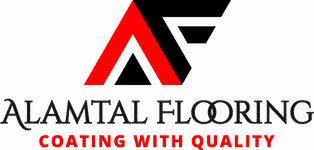Among the primary positive attributes of epoxy flooring is the fact that when it is installed, it integrates with the building’s structure by sticking tightly to the concrete. Floors treated in this way tend to last between 10 and 20 years, and perhaps even longer than that, as long as regular maintenance is performed. When the time comes for a flooring replacement, removal of the existing surface will be unnecessary, and there is no waste from the demolition of materials. As such, epoxy flooring represents an impressively sustainable option for those who are environmentally conscious.
There are numerous finishes and colors available in epoxy flooring, so you always stand a good chance of finding exactly what you want. Customers can find an array of hues and finish styles that make for a smooth, highly-protective final product on the flooring surface. There is almost no limit to what can be achieved, and it really is possible to let your creative side take hold. Custom logos, dye stains, metallic finishes, and quartz-look results can be achieved, further boosting the versatility of these products.
Epoxy-coated floors do require certain cleaning methods, but they are not at all difficult. Because dirt and dust never attach to the surface itself, simply use a dust mop on a weekly basis to keep things nice and tidy. If your epoxy floor receives a great deal of soiling and traffic, you can do a thorough cleaning once per quarter, just making sure to avoid cleaning products containing vinegar or citrus elements.
These two options share the ability to be used as topcoats or midcoats. However, epoxy remains the leader in primers within the industrial realm. Both types of coatings work well with resins such as urethane mortar, and they can be used on virtually all varieties of concrete. Further, polyaspartics and epoxies offer characteristics that render them extremely versatile in floor and other concrete applications. It is easy to customize these coatings to perfectly suit a facility’s needs, and they can also incorporate attractive decorative elements such as flaking, powders, and colorful chips. One realm in which these two options differ, however, is installation time. Polyaspartics cure more quickly than epoxy, which can require anywhere between six and eight hours to do so. Quick installation and reduced labor expenses can make polyaspartics ideal for many. They sometimes need as little as two hours to be fully traffic-ready, so they can be great in hospitals and similarly fluid facilities.
When a garage floor begins to show its signs of age through chipping, peeling and pitting, it may be time to utilize one of the terrific covering products available on the market. Many homeowners find epoxy coatings to be ideal solutions to just this type of situation. Garage flooring can be fully rejuvenated and made to look as good as new. In order to get optimal results, application of an epoxy is best performed by a trained, professional technician. This is particularly true if the floor at issue is showing serious signs of wear and tear.
Other terrific applications for concrete floor coatings include porches, steps, walkways, driveways, showers, and even pool decks. Given the fact that surfaces treated in this manner are highly resistant to dirt, they are ideal for areas that are highly trafficked, including kitchens, family rooms, and garage spaces.
Given that lots of people use the garage to enter and exit the home on a daily basis, it is important that the coating process does not render the space unusable for a long period. As such, it is necessary to know just how much time the entire job requires. In terms of a “complete” job, it important to note the time involved from initial application to the point when the garage can be used as normal. Depending on the coating selected, this time frame can vary. Epoxy coatings tend to take three days in terms of application, and that must happen when the temperature is higher than freezing. Polyaspartic coatings cure rapidly, between five and 120 minutes, depending on how warm the day is, and it can also be applied within a range of ambient temperatures.
Lots of homeowners are moving toward epoxy floor coatings, largely because it is visually appealing, easy-to-clean, and hard wearing. Floors treated in this way look much better than plain concrete, and they are more durable than painted surfaces. The stain-resistant nature of the products and their ability to cover defects and cracking make them even more attractive. High-gloss surfaces of this type are likely to be slippery if wet, and that is true of epoxies. To balance this, it is possible to utilize an anti-skid additive such as polymer grit, silica sand, pumice, or something similar.
Perhaps you are hoping to have a coated flooring surface applied during a particular time of the year, but you may not realize that there are temperature limitations at play. Expoxy’s can only be applied if the temperature is at least between 50 and 55 degrees. Urethane coatings require a minimum temperature of 40 degrees Fahrenheit for application. As such, anyone living in a colder climate will have a narrower installation window than others. It should be noted, though, that polyaspartic coatings have far fewer limitations based on temperature, and they can be applied in extreme cold, all the way as low as -22 degrees Fahrenheit. Temperature will, however, impact curing time.
Though not everyone considering a concrete floor coating option may not be overly worried about the environmental impact, many homeowners will be. The fact is that there are certain types of coatings that do emit greater amounts of VOCs, or volatile organic compounds, than their competitors. These are released into the air slowly, and they can be damaging to the environment. Polyaspartic coatings are known for their low VOC emissions, making them a terrific choice for anyone worried about staying green.
When selecting a coating for any garage floor, durability is certainly going to be a primary concern. Nobody wants to spend a great deal of money on a coating only to have it start to fail within a year or so. Fortunately, polyaspartic coatings are extremely long-lasting and even more durable than expoxy coatings. Top-level polyaspartic coatings:
- Keep their glossy finishes longer and resist yellowing
- Add waterproofing to the garage
- Offer impact and abrasion resistance
- Ward off “hot tire pickup” known for leaving stains on floor surfaces
Of course, all garage flooring will need some form of maintenance and cleaning in order to reach its longest possible lifespan, but these options require far less than many alternatives.
If you are contemplating a home sale anytime in the relatively near future, you may be pondering what sort of improvements you can make now that will not cost a great deal, but will provide maximum impact on selling price. This is a strategic decision that every prospective seller has to make at one point or another. Among the tasks many homeowners undertake in advance of listing their property are things such as adding fresh paint throughout the house, improving the landscape for extra curb appeal, and maybe even some kitchen and bath upgrades. Not everyone thinks about improving the look and functionality of their garage space, and that is an easy mistake to correct.



